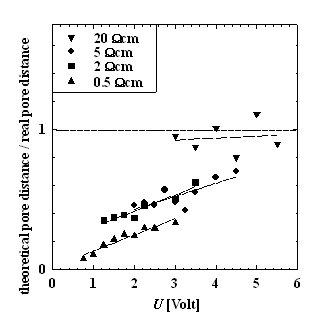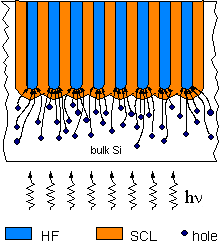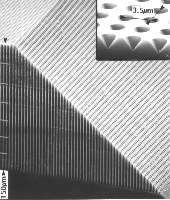 |
The limits of the space-charge-model on
n-type-silicon |
| |
 |
There is a limit for the doping-level of the silicon on n-type. As show in
different paper stabil macropore-growth is easyler to aproache in low doped
silicon-wafers. The space-charge-region-model defines no limit for the
doping-level. Sometimes break-trough-mechanismen were used to explain this lack
in the model. |
|
| |
|
|
|
| |
|
|
|
| |
 |
In an work about
random-macropores in n-type-silicon we found that the space-charge-region
defines the distance of macropores by using low doped silicon. The models
breaks down at higher doped silicon - see figure below. |
 |
| |
|
|
|
| |
|
|
|
 |
The effective
macropore-wall-passivation |
| |
 |
Since we find a strong reorganization of pores in the nucleation phase
especially in the case when macropore growth is not very stable. i.e. at high
doping levels, we have to discuss an additional fea-ture: Not every pore which
can grow under the experimental conditions will grow in the stable phase. There
is a certain possibility, that although sufficient minority carriers are
present (otherwise no pore tip would have been formed), some pores will cease
to grow and thus allow neighboring pores to increase their diameter. In
consequence, not each minority carrier which reaches a pore tip will lead the a
chemical reaction at this tip; there must be a possibility for a carrier to
leave the pore tip again and to diffuse to another pore. This possibility can
be quantified by a statistical chemical transfer rate and/or a time dependent
chemical passivation of the pore tip by an oxide layer, which must be
dissolved, before new minority carriers can be consumed.We thus are lead to believe in some passivation mechanism
operative during pore etching. The passivation is the hydrogen
passivation at the pore-walls. |
 |
| |
|
|
|
| |
|
|
|
 |
The anisotropic macropore-growth
|
| |
 |
We found that the <100>- and
<113>-directions are growth directions of the macropores in
n-type-silicon (presented in the paper
form S. Rönnebeck et al.). The growth-directions correspond with the
kinetics of the hygrogen-passivation. The (100) has got the slowst kinetic - it
took a long time to passivate. The TEM-investigations shows (111)-facetts at the
pore-walls - macropore-growth is an anisotropic process. |
 |
| |
|
|
|
| |
|
|
|




